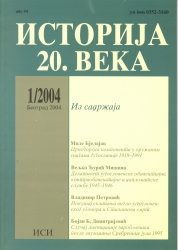Tenkovi i modernizacija Jugoslovenske vojske 1919–1931
Tanks and Modernization of the Yugoslav Army, 1919-1931
Author(s): Dalibor DendaSubject(s): History
Published by: Institut za savremenu istoriju, Beograd
Keywords: tanks; modernization; Yugoslav army; 1919-1931; Second World War;
Summary/Abstract: Tanks, as a new military tool, appeared in the First World War. Even though they were far from technical perfection, tanks played a very significant, and according to certain people even a crucial, part in the victory over the Entente powers. It is important to emphasize the psychological and moral effect that the appearance of this, at that time new, tool had on the conscience of a man. The military establishment’s attitude on the provision and introduction of tanks in the armament of the Yugoslav Army was positive and timely. The plan on provision, with reference to material difficulties of the country and technical imperfection of tanks, was adopted soon after the First World War had ended. Due to economic weakness of the country, the only way of the Army modernization was with the help of the French war loan from 1923 on the basis of which more serious delivery began at the end of 1927. The Yugoslav Army establishment tried everything in its power to carry out this provision as soon as possible and to train the personnel for operating these tanks. However, the advantage, as far as provision is concerned, was given to the needs for military uniforms and tents. The reasons for this can be found in bad conditions with uniforms in the Yugoslav Army. Sending Yugoslav men on training in the French Army coincided with the indication of the possible provision of tanks. First, the artillery and then the infantry officers were sent there in compliance with the change of views according to which tanks were classified as the tools of infantry, instead of the tools of stormy troops. While tanks were being provided, the tank company was formed in Kragujevac. In July of 1931, they were transferred to Kalinovnik as a part of Infantry and Artillery officer’s school where they were mostly used for training. These tanks, technically imperfect and outdated, were a main military tool in armament of the Yugoslav Army armored units until the very beginning of the Second World War.
Journal: Istorija 20. veka
- Issue Year: 2004
- Issue No: 1
- Page Range: 21-37
- Page Count: 16
- Language: Serbian

